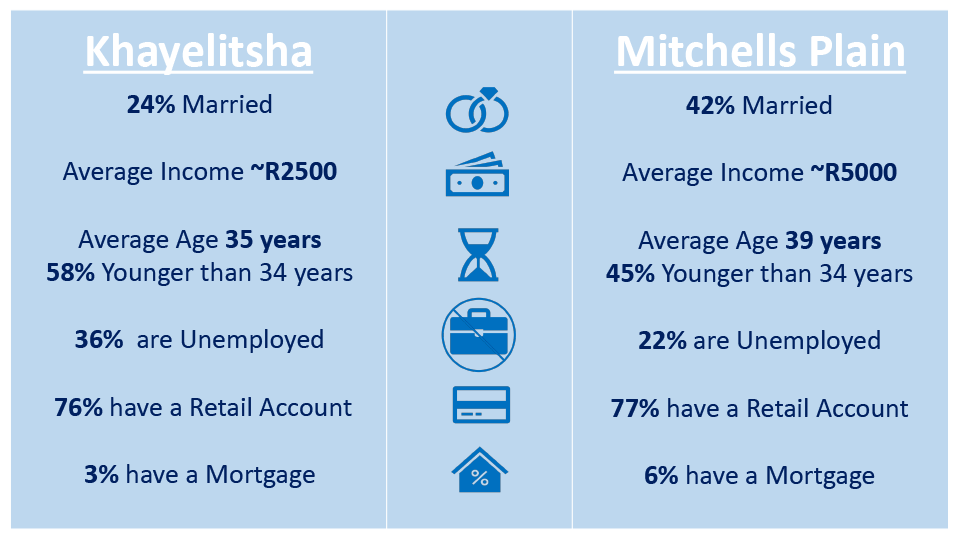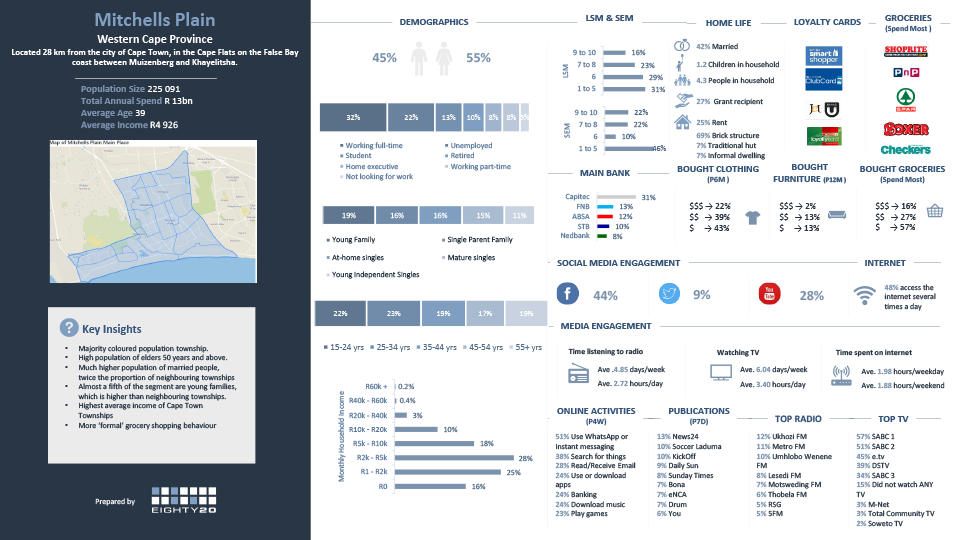A tale of two nations
In 1998, Thabo Mbeki, then South Africa’s deputy president, spoke of South Africa as one country, but two nations. He spoke about one being black and the other white. “One of these nations is white, relatively prosperous, regardless of gender or geographic dispersal. It has ready access to a developed economic, physical, educational, communication and other infrastructure.” He went on to say, “The second and larger nation of South Africa is black and poor…”

Eighty20’s ENS Customer Profiling Tool merges a variety of secondary and administrative datasets providing a comprehensive view of the South African consumer. The tool also links these databases back to a geography, so comparisons of neighbourhoods can be made.
Using the ENS to compare townships (generally underdeveloped urban areas, created for people of colour under Apartheid) with more formal, wealthier areas, reveals how different communities still are despite them being so close to each other. In the case of Rondebosch and Athlone; Plumstead and Grassy Park; and Pinelands and Langa, in the City of Cape Town, these “two nations” are only separated by a single road. We explored some differences.
Neighbouring areas Athlone and Rondebosch are separated by only the M5 Highway, but the demographics of the people who live there are quite different, as are Plumstead and Grassy Park. The average income of an Athlone resident is a fifth of the average Rondebosch income, and Plumstead has less than half the population of Grassy Park while each resident of Plumstead has on average two and a half times their income.
Nearly 30% of Pinelands residents have mortgages, but just across the two lane M17 in Langa the number is a tenth of that. The residents of Langa are on average 10 years younger and earn about 85% less than those in Pinelands. Residents of Pinelands are also more than twice as likely to be married as those in Langa.
In terms of credit products, consumers in Langa, Grassy Park and Athlone are much more likely to have retail credit and unsecured loans (with lower current balances) but only half as likely to have a credit card as people in Pinelands, Rondebosch and Plumstead. Almost all of the ~1.8m mortgages are held by a small group of just over 2m people, and most are concentrated in the wealthier neighborhoods across South Africa. Penetration of credit products such as mortgages that help grow an individual’s long term wealth, is not only very low in poorer areas of South Africa, but the entire product category isn’t growing, with the number of new mortgages last year still lower than in 2008.
Interestingly, even when comparing neighbouring township areas, the stark contrast in terms of family structure, marital status, average income and age are also visible. Only a small band of asphalt, The M49, separates Mitchells Plain from Khayelitsha, but when you look at the demographics, two very distinct pictures emerge. Some 42% of the population of Mitchells Plain is married, has an average income of nearly R5,000 per month, and 45% of the population is younger than 34. Compare this with Khayelitsha where only 24% are married and the average income is half that of Mitchells Plain, with nearly 60% of the population younger than 34.
In order to better understand the differences between neighborhoods, Eighty20 developed affluence and inequality metrics to aid comparison. We took into account the existing Living Standards Measure (LSM), whether they shop at higher end or lower end stores, as well as their long term investment holdings to determine an overall Affluence score for each location. We compared a variety of weightings of the three components and settled on a relatively even rating across all three. When using this measure, Rondebosch, Pinelands and Plumstead have High Affluence scores. Grassy Park, Mitchells Plain and Athlone have a Medium Affluence while Khayelitsha and Langa are both rated Low Affluence.
We also looked at the Gini coefficient in each area. While the Gini measure is often used to show the inequality in society, within a smaller area or township it looks at the range of incomes within one area. Out of the areas mentioned above, Athlone has the highest level of wealth inequality in one neighbourhood, with Pinelands and Plumstead proving to be more homogenous areas.
| Area | Affluence Percentile | Affluence Rating | GINI Coefficient | Wealth Inequality |
|---|---|---|---|---|
| Pinelands | 97 | High | 0.53 | Low |
| Rondebosch | 97 | High | 0.57 | Below Average |
| Plumstead | 89 | High | 0.54 | Low |
| Grassy Park | 69 | Medium | 0.61 | Below Average |
| Mitchells Plain | 65 | Medium | 0.57 | Below Average |
| Athlone | 60 | Medium | 0.65 | Above Average |
| Langa | 37 | Low | 0.63 | Below Average |
| Khayelitsha | 23 | Low | 0.64 | Below Average |
Nearly 25 years on from Mbeki’s two nations speech, we can still see significant inequality, although it is no longer as neatly separated along ethic or geographical boundaries. It is not only interesting how close wealthy and poor South Africans live in certain urban areas but also, how even within neighbourhoods, this inequality has emerged.
